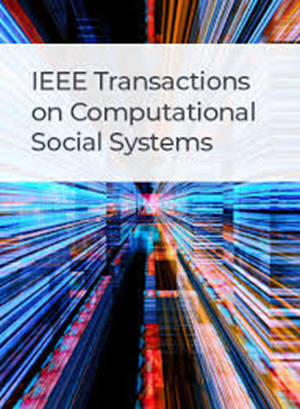跨数据粒度链接:拟合多元Hawkes过程到部分间隔截尾数据
IF 4.5
2区 计算机科学
Q1 COMPUTER SCIENCE, CYBERNETICS
IEEE Transactions on Computational Social Systems
Pub Date : 2024-11-12
DOI:10.1109/TCSS.2024.3486117
引用次数: 0
摘要
多元Hawkes过程(multivariate Hawkes process, MHP)广泛用于分析相互交互的数据流,其中事件在其自身维度内(通过自激励)或跨不同维度(通过交叉激励)生成新事件。然而,在某些应用程序中,某些维度中单个事件的时间戳是不可观察的,并且只知道间隔内的事件计数,称为部分间隔审查数据。MHP不适合处理这类数据,因为它的估计需要事件时间戳。在本研究中,我们引入了部分截尾多元Hawkes过程(PCMHP),这是一种新的点过程,它与MHP具有参数等价性,可以有效地对时间戳数据和间隔截尾数据建模。我们使用合成数据集和实际数据集演示了PCMHP的功能。首先,我们证明了PCMHP可以近似MHP参数并使用合成事件历史恢复光谱半径。接下来,我们评估了PCMHP在预测YouTube流行度方面的性能,发现PCMHP优于流行度估计算法Hawkes强度过程(HIP)[1]。与完全间隔截除的HIP相比,我们发现PCMHP通过考虑点过程维度提高了预测性能,特别是当存在显著的跨维度相互作用时。最后,我们利用PCMHP从包含多个国家每日COVID-19病例计数和COVID-19相关新闻文章的数据集中获得定性见解。通过对pcmhp模型国家进行聚类,我们揭示了COVID-19病例发生与新闻报道之间隐藏的相互作用模式。本文章由计算机程序翻译,如有差异,请以英文原文为准。
Linking Across Data Granularity: Fitting Multivariate Hawkes Processes to Partially Interval-Censored Data
The multivariate Hawkes process (MHP) is widely used for analyzing data streams that interact with each other, where events generate new events within their own dimension (via self-excitation) or across different dimensions (via cross excitation). However, in certain applications, the timestamps of individual events in some dimensions are unobservable, and only event counts within intervals are known, referred to as partially interval-censored data. The MHP is unsuitable for handling such data since its estimation requires event timestamps. In this study, we introduce the partially censored multivariate Hawkes process (PCMHP), a novel point process that shares parameter equivalence with the MHP and can effectively model both timestamped and interval-censored data. We demonstrate the capabilities of the PCMHP using synthetic and real-world datasets. First, we illustrate that the PCMHP can approximate MHP parameters and recover the spectral radius using synthetic event histories. Next, we assess the performance of the PCMHP in predicting YouTube popularity and find that the PCMHP outperforms the popularity estimation algorithm Hawkes intensity process (HIP) [1] . Comparing with the fully interval-censored HIP, we show that the PCMHP improves prediction performance by accounting for point process dimensions, particularly when there exist significant cross-dimension interactions. Last, we leverage the PCMHP to gain qualitative insights from a dataset comprising daily COVID-19 case counts from multiple countries and COVID-19-related news articles. By clustering the PCMHP-modeled countries, we unveil hidden interaction patterns between occurrences of COVID-19 cases and news reporting.
求助全文
通过发布文献求助,成功后即可免费获取论文全文。
去求助
来源期刊

IEEE Transactions on Computational Social Systems
Social Sciences-Social Sciences (miscellaneous)
CiteScore
10.00
自引率
20.00%
发文量
316
期刊介绍:
IEEE Transactions on Computational Social Systems focuses on such topics as modeling, simulation, analysis and understanding of social systems from the quantitative and/or computational perspective. "Systems" include man-man, man-machine and machine-machine organizations and adversarial situations as well as social media structures and their dynamics. More specifically, the proposed transactions publishes articles on modeling the dynamics of social systems, methodologies for incorporating and representing socio-cultural and behavioral aspects in computational modeling, analysis of social system behavior and structure, and paradigms for social systems modeling and simulation. The journal also features articles on social network dynamics, social intelligence and cognition, social systems design and architectures, socio-cultural modeling and representation, and computational behavior modeling, and their applications.
 求助内容:
求助内容: 应助结果提醒方式:
应助结果提醒方式:


